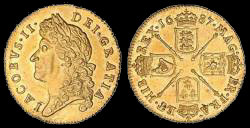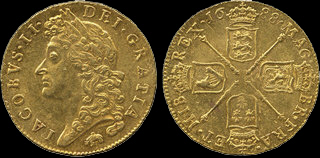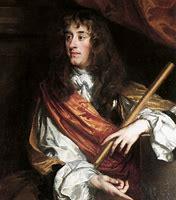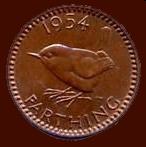













The Paragon Of Metal Detecting
Powered By Sispro1
British Sterling Currency - Numismatics,
Guinea
For Reference ONLY
Everything For The Detectorist


James II 1685-1688 AD
Royal Monarchy
Copyright All Rights Reserved by Nigel G Wilcox E-Mail: ngwilcox100@gmail.com
Designed by Nigel G Wilcox

INFORMATION - DATA
Pages
The first guinea was produced on 6 February 1663; a proclamation of 27 March 1663 made the coins legal currency. One troy pound of 11/12 fine gold (22 carat or 0.9167 pure by weight) would make 44½ guineas, each thus theoretically weighing 129.438 grains (8.385 grams crown gold, 7.688 grams fine gold, or 0.247 troy ounces fine gold). As of 21 December 2017, the price of gold is $1267.20 per troy ounce. This makes a pound worth $313.24 USD and a penny valued at $1.305 or 0.98 GBP British Pounds.
The denomination was originally worth one pound, or twenty shillings, but an increase in the price of gold during the reign of King Charles II led to the market trading it at a premium. The price of gold continued to increase, especially in times of trouble, and by the 1680s, the coin was worth 22 shillings. Indeed, in his diary entries for 13 June 1667, Samuel Pepys records that the price was 24 to 25 shillings.
The diameter of the coin was 1 inch (just over 25 mm) throughout Charles II's reign, and the average gold purity (from an assay done in 1773 of samples of the coins produced during the preceding year) was 0.9100. "Guinea" was not an official name for the coin, but much of the gold used to produce the early coins came from Guinea in Africa.
The coin was produced each year between 1663 and 1684, with the elephant appearing on some coins each year from 1663 to 1665 and 1668, and the elephant and castle on some coins from 1674 onward. The elephant, with or without the castle, symbolises the Royal African Company (founded in 1660), whose activities on the Guinea Coast of Africa resulted in the importation of much gold into England.
Coins of each year were issued both with and without the elephant and castle mark. The king's head faces left in this reign, and is surrounded by the inscription IACOBUS II DEI GRATIA ("James II by the grace of God"), while the reverse is the same as in Charles II's reign except for omitting the interlinked "C"s in the centre of the coin. The edge of the coins are milled diagonally.
The denomination was originally worth one pound, or twenty shillings, but an increase in the price of gold during the reign of King Charles II led to the market trading it at a premium. The price of gold continued to increase, especially in times of trouble, and by the 1680s, the coin was worth 22 shillings. Indeed, in his diary entries for 13 June 1667, Samuel Pepys records that the price was 24 to 25 shillings.
The diameter of the coin was 1 inch (just over 25 mm) throughout Charles II's reign, and the average gold purity (from an assay done in 1773 of samples of the coins produced during the preceding year) was 0.9100. "Guinea" was not an official name for the coin, but much of the gold used to produce the early coins came from Guinea in Africa.
The coin was produced each year between 1663 and 1684, with the elephant appearing on some coins each year from 1663 to 1665 and 1668, and the elephant and castle on some coins from 1674 onward. The elephant, with or without the castle, symbolises the Royal African Company (founded in 1660), whose activities on the Guinea Coast of Africa resulted in the importation of much gold into England.
Coins of each year were issued both with and without the elephant and castle mark. The king's head faces left in this reign, and is surrounded by the inscription IACOBUS II DEI GRATIA ("James II by the grace of God"), while the reverse is the same as in Charles II's reign except for omitting the interlinked "C"s in the centre of the coin. The edge of the coins are milled diagonally.
Guinea
James II

Main Coin Menu

VIEW ALL MENUS
Member NCMD
6. S. Menu
























